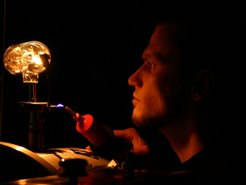Data, meet faulty Voltage-current probe. Voltage-current probe, meet data of 2008. Goodbye, both of you.
One of the biggest fears and anxieties of a scientist will always be the integrity of his data. We are using immensely complex instruments to measure stuff, so how do we know that those instruments are not lying to us? Via calibration and comparison - here is how that can fail miserably:
Measuring voltage and current is normally straigth-forward, but becomes less so if you leave the familiar pastures of direct current behind and venture into the dark and dangerous woods of very high frequency and voltage. A normal oscilloscope probe will then not do anymore - it's maximum voltage derates quite quickly with rising frequency - So much so that I am measuring my measly 2kV with a 25kV probe, which is only just capable of doing that.
Enter the evil, evil ENI low-impedance voltage-current probe. I installed it in the beginning of this year, and assiduously compared it's measurement with the 'scope. They agreed just fine, so I went ahead and used the thing, since it comes with a PC interface and logging software. Still, from time to time I compared it's measurements with the 'scope, just to be sure.
Today I found out that the evil, evil ENI low-impedance voltage-current probe isn't. Low-impedance that is. In fact, depending on the voltage it can act as a 1:4 to 1:20 voltage divider - meaning that all I have measured this year is crap. And I never discovered that, because I never thought of taking the thing physically out of the circuit - I only compared it's measurements with the 'scope, which of course showed the same voltage, since the probe was still there, happily acting as a divider.
I will have to redo all my measurements of this year. The most depressing thing? It will probably only take two to three weeks.
Some weeks it would be better just to stay in bed.
2 months ago



No comments:
Post a Comment